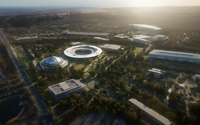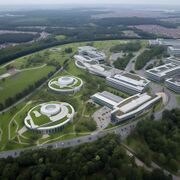User:Belfras/SandboxSpace2: Difference between revisions
No edit summary |
No edit summary |
||
| Line 19: | Line 19: | ||
| expenses = | | expenses = | ||
| expenses_year = | | expenses_year = | ||
| membership = {{ | | membership = Member states:{{Unbulleted list|titlestyle = background:transparent;text-align:left;font-weight:normal; | ||
|{{flag|Alanahr}} | |{{flag|Alanahr}} | ||
|{{flag|Arthurista}} | |{{flag|Arthurista}} | ||
| Line 39: | Line 38: | ||
|{{flag|Yisrael}} | |{{flag|Yisrael}} | ||
}} | }} | ||
| languages = | | languages = {{wpl|latin}} (official) | ||
| leader_title = Director-General | | leader_title = Director-General | ||
| leader_name = Deckard Gleise | | leader_name = Deckard Gleise | ||
| Line 53: | Line 52: | ||
{{clear}} | {{clear}} | ||
= Unsure = | |||
== Facilities == | |||
The facilities operated by the Joint Space Agency are distributed among various countries and areas. The primary facilities, such as the primary headquarters, launch facility and research campus are separated among the three founding members in an arrangement that dates back to the initial founding of the agency. | |||
* JSA headquarters in Thessalona, [[Belfras]], | |||
* Ekporte KeParaguasure Okeere (EKPO) launch site in [[Sante Reze]], | |||
* XXXX research center in [[Latium]], | |||
* Facilities oeprated by member state space agencies but have close collaboration with the JSA include; | |||
** Cape Castille Space Port in [[Gristol-Serkonos]], | |||
** National Space Training Center in [[Belfras]], | |||
{{Gallery | |||
| title = | |||
| align = Center | |||
| height = | |||
| width = 200 | |||
|footer= | |||
|mode= | |||
| File:JSA_HQ_in_Belfras.png | |||
| alt1= | |||
| JSA's headquarters campus in [[Belfras]] | |||
| File:Launch Pad 39A (KSC-66C-6852).jpg | |||
| alt2= | |||
| EKPO, the JSA's main launch site in [[Sante Reze]] | |||
| File:JSA research Center.jpg | |||
| alt3= | |||
| XXXX research center in [[Latium]] | |||
| File:Rocket Launch 201211-X-DM484-001M.jpg | |||
| alt4= | |||
| Launch of a Diana VII SH at EKPO, 2021 | |||
| File:X-37B mission (2003366659).jpg | |||
| alt5= | |||
| Launch of Phoenix 2 HLV carrying supplies for the Lunar ACA base, 2023 | |||
}} | |||
= Organisation etc = | = Organisation etc = | ||
== Organisation == | == Organisation == | ||
As planned in the Conventions two organs are defined which work together to run the Joint Space Agency; the Space Council and the Director-General. The Space Council is composed of ministers of the member states which meets as required at ministerial or delegate level. The Director-General is appointed by the space council and serves at their leisure and in their duty represents the JSA in it's acts and executes policy defined by the Space Council. The Council has set-up subordinate bodies to be assisted in it's duties. Each of the Committees and Boards take decisions, make recommendations or are kept informed according to the amount of powers invested in them by the Council in their given area of responsibilities. Each Member States nominates its representation to the boards and committees; these delegates are often accompanied by experts. | |||
The primary role of the Space Council is to establish the direction and policy of the Joint Space Agency. Ministers of the space council meet every two to three years to assess current challenges, opportunities, and technological advancements in space exploration and then decide on the agency's priorities and initiatives for the forthcoming period. The Space Council is also responsible for overseeing the implementation of these policies, and to this end they appoint a director-general who will act as the executive officer for the agency and ensure that the agency's activities align with the established goals and regulatory guidelines. Oversight over these activities are conducted through an executive committee whose responsibilities include conducting oversight over all established activities and programmes, over the different divisions and support services, and finally over the director-general and administrative staff themselves. | |||
Ministers in the Space Council will be charged with appointing teams of experts to their staff and assigning delegates to attend lesser meetings which are foxued on specific programmes and initiatives. These delegates and meetings allow for focused discussions, expert contributions, and a more agile decision-making regarding particular projects by avoiding unnecessary administrative efforts. As stated in the conventions, the contributions of the ministers as representatives of the members states promotes international cooperation. This collaboration fosters a unifieid approach to address global challenges in space research, technological advancement, and policy regulation, furthering the peaceful exploration and utilization of outer space. | |||
=== Divisions and services === | |||
= Spaceflight = | |||
== Activities and Programmes == | |||
The Joint Space Agency has, since it's inception, described the work it carries out as either an activity or a programme. The difference between these two are that | |||
The ESA describes its work in two overlapping ways: | |||
For the general public, the various fields of work are described as "Activities". | |||
Budgets are organised as "Programmes". | |||
These are either mandatory or optional. | |||
Revision as of 13:27, 16 November 2024
New datasheet
Sodalitas Cosmos Agencia (latin) | |
 Logo | |
 Meatball | |
| File:JSA Membership.png Member states shown in dark blue | |
| Abbreviation | SCA (latin) |
|---|---|
| Formation | 1 August 1968 |
| Type | Space agency Aeronautics research agency |
| Headquarters | Thessalona, Belfras |
Membership | Member states: |
Official languages | latin (official) |
Director-General | Deckard Gleise |
Deputy Director-General | XXXX |
Unsure
Facilities
The facilities operated by the Joint Space Agency are distributed among various countries and areas. The primary facilities, such as the primary headquarters, launch facility and research campus are separated among the three founding members in an arrangement that dates back to the initial founding of the agency.
- JSA headquarters in Thessalona, Belfras,
- Ekporte KeParaguasure Okeere (EKPO) launch site in Sante Reze,
- XXXX research center in Latium,
- Facilities oeprated by member state space agencies but have close collaboration with the JSA include;
- Cape Castille Space Port in Gristol-Serkonos,
- National Space Training Center in Belfras,
JSA's headquarters campus in Belfras
EKPO, the JSA's main launch site in Sante Reze
XXXX research center in Latium
Organisation etc
Organisation
As planned in the Conventions two organs are defined which work together to run the Joint Space Agency; the Space Council and the Director-General. The Space Council is composed of ministers of the member states which meets as required at ministerial or delegate level. The Director-General is appointed by the space council and serves at their leisure and in their duty represents the JSA in it's acts and executes policy defined by the Space Council. The Council has set-up subordinate bodies to be assisted in it's duties. Each of the Committees and Boards take decisions, make recommendations or are kept informed according to the amount of powers invested in them by the Council in their given area of responsibilities. Each Member States nominates its representation to the boards and committees; these delegates are often accompanied by experts.
The primary role of the Space Council is to establish the direction and policy of the Joint Space Agency. Ministers of the space council meet every two to three years to assess current challenges, opportunities, and technological advancements in space exploration and then decide on the agency's priorities and initiatives for the forthcoming period. The Space Council is also responsible for overseeing the implementation of these policies, and to this end they appoint a director-general who will act as the executive officer for the agency and ensure that the agency's activities align with the established goals and regulatory guidelines. Oversight over these activities are conducted through an executive committee whose responsibilities include conducting oversight over all established activities and programmes, over the different divisions and support services, and finally over the director-general and administrative staff themselves.
Ministers in the Space Council will be charged with appointing teams of experts to their staff and assigning delegates to attend lesser meetings which are foxued on specific programmes and initiatives. These delegates and meetings allow for focused discussions, expert contributions, and a more agile decision-making regarding particular projects by avoiding unnecessary administrative efforts. As stated in the conventions, the contributions of the ministers as representatives of the members states promotes international cooperation. This collaboration fosters a unifieid approach to address global challenges in space research, technological advancement, and policy regulation, furthering the peaceful exploration and utilization of outer space.
Divisions and services
Spaceflight
Activities and Programmes
The Joint Space Agency has, since it's inception, described the work it carries out as either an activity or a programme. The difference between these two are that
The ESA describes its work in two overlapping ways:
For the general public, the various fields of work are described as "Activities". Budgets are organised as "Programmes". These are either mandatory or optional.




